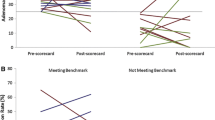Abstract
Background
Body mass index (BMI), age, and gender influence colorectal cancer (CRC) and adenoma risk. Their effects on colonoscopy characteristics are unclear, but might inform the screening approach in patient subgroups.
Aims
The aims of this study were to assess the effect of BMI, age, and gender on prep quality, amount of sedation, procedure time, and adenoma prevalence for screening colonoscopy.
Methods
We conducted a review of 773 eligible colonoscopies performed for average-risk CRC screening. We performed multivariable regression analyses to assess the outcomes of prep quality, amount of fentanyl and midazolam used, procedure time, and the adenoma prevalence rate (APR).
Results
Obese patients were less likely (p = 0.01) to have a good or excellent prep, had similar procedure times, and received similar amounts of fentanyl and midazolam. Increasing age had no effect on prep quality or procedure time, but was associated with decreased fentanyl and midazolam (both p ≤ 0.001). Women had similar prep quality, longer procedure times (increased by 2.8 ± 0.7 min, p < 0.001) for colonoscopies in which no polyps were detected, and received more fentanyl and midazolam (both p = 0.01). Increasing BMI, increasing age, and male gender were associated with an increased APR. The APR for women aged 50–59 with a normal BMI was 17.9 %.
Conclusions
Normal-weight females, particularly those under age 60, have the lowest APR but have longer procedure times and require higher amounts of sedation. Screening options other than colonoscopy might be well-suited to this population.


Similar content being viewed by others
Abbreviations
- ADR:
-
Adenoma prevalence rate
- CRC:
-
Colorectal cancer
- BMI:
-
Body mass index
References
Siegel R, Naishadham D, Jemal A. Cancer statistics for Hispanics/Latinos, 2012. CA Cancer J Clin. 2012;62:283–298. doi:10.3322/caac.21153.
Shapiro JA, Klabunde CN, Thompson TD, Nadel MR, Seeff LC, White A. Patterns of colorectal cancer test use, including CT colonography, in the 2010 National Health Interview Survey. Cancer Epidemiol Biomarkers Prev. 2012;21:895–904. doi:10.1158/1055-9965.EPI-12-0192.
Mandel JS, Bond JH, Church TR, et al. Reducing mortality from colorectal cancer by screening for fecal occult blood. Minnesota Colon Cancer Control Study. N Engl J Med. 1993;328:1365–1371.
Mandel JS, Church TR, Bond JH, et al. The effect of fecal occult-blood screening on the incidence of colorectal cancer. N Engl J Med. 2000;343:1603–1607.
Atkin WS, Edwards R, Kralj-Hans I, et al. Once-only flexible sigmoidoscopy screening in prevention of colorectal cancer: a multicentre randomised controlled trial. Lancet. 2010;375:1624–1633. doi:10.1016/S0140-6736(10)60551-X.
Calle EE, Rodriguez C, Walker-Thurmond K, Thun MJ. Overweight, obesity, and mortality from cancer in a prospectively studied cohort of U.S. adults. N Engl J Med. 2003;348:1625–1638.
Hoffmeister M, Schmitz S, Karmrodt E, et al. Male sex and smoking have a larger impact on the prevalence of colorectal neoplasia than family history of colorectal cancer. Clin Gastroenterol Hepatol. 2010;8:870–876. doi:10.1016/j.cgh.2010.07.004.
Nguyen SP, Bent S, Chen YH, Terdiman JP. Gender as a risk factor for advanced neoplasia and colorectal cancer: a systematic review and meta-analysis. Clin Gastroenterol Hepatol. 2009;7:676–681.e671-673. doi:10.1016/j.cgh.2009.01.008.
Okabayashi K, Ashrafian H, Hasegawa H, et al. Body mass index category as a risk factor for colorectal adenomas: a systematic review and meta-analysis. Am J Gastroenterol. 2012;107:1175–1185; quiz 1186. doi:10.1038/ajg.2012.180.
Renehan AG, Tyson M, Egger M, Heller RF, Zwahlen M. Body-mass index and incidence of cancer: a systematic review and meta-analysis of prospective observational studies. Lancet. 2008;371:569–578. doi:10.1016/S0140-6736(08)60269-X.
Giovannucci E, Ascherio A, Rimm EB, Colditz GA, Stampfer MJ, Willett WC. Physical activity, obesity, and risk for colon cancer and adenoma in men. Ann Intern Med. 1995;122:327–334.
Hsieh YH, Kuo CS, Tseng KC, Lin HJ. Factors that predict cecal insertion time during sedated colonoscopy: the role of waist circumference. J Gastroenterol Hepatol. 2008;23:215–217. doi:10.1111/j.1440-1746.2006.04818.x.
Borg BB, Gupta NK, Zuckerman GR, Banerjee B, Gyawali CP. Impact of obesity on bowel preparation for colonoscopy. Clin Gastroenterol Hepatol. 2009;7:670–675. doi:10.1016/j.cgh.2009.02.014.
Imperiale TF, Glowinski EA, Lin-Cooper C, Ransohoff DF. Tailoring colorectal cancer screening by considering risk of advanced proximal neoplasia. Am J Med. 2012;125:1181–1187. doi:10.1016/j.amjmed.2012.05.026.
Winawer SJ, Zauber AG, Fletcher RH, et al. Guidelines for colonoscopy surveillance after polypectomy: a consensus update by the US Multi-Society Task Force on Colorectal Cancer and the American Cancer Society CA Cancer J Clin. 2006;56:143–159; quiz 184–145.
Flegal KM, Carroll MD, Kit BK, Ogden CL. Prevalence of obesity and trends in the distribution of body mass index among US adults, 1999–2010 JAMA. 2012;307:491–497. Epub 2012 Jan 2017.
Khiani VS, Salah W, Maimone S, Cummings L, Chak A. Sedation during endoscopy for patients at risk of obstructive sleep apnea. Gastrointest Endosc. 2009;70:1116–1120. doi:10.1016/j.gie.2009.05.036.
Elphick DA, Donnelly MT, Smith KS, Riley SA. Factors associated with abdominal discomfort during colonoscopy: a prospective analysis. Eur J Gastroenterol Hepatol. 2009;21:1076–1082. doi:10.1097/MEG.0b013e32832357b3.
Conflict of interest
None.
Author information
Authors and Affiliations
Corresponding author
Rights and permissions
About this article
Cite this article
Czwornog, J., Austin, G.L. Body Mass Index, Age, and Gender Affect Prep Quality, Sedation Use, and Procedure Time During Screening Colonoscopy. Dig Dis Sci 58, 3127–3133 (2013). https://doi.org/10.1007/s10620-013-2746-2
Received:
Accepted:
Published:
Issue Date:
DOI: https://doi.org/10.1007/s10620-013-2746-2




